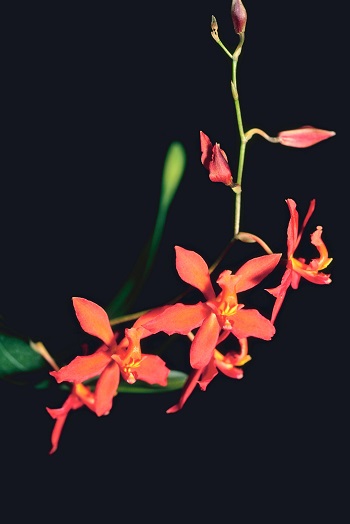
Depending on the type of Orchid you choose to grow, how and what to grow it in or on (if anything) is entirely up to you. If it works for you, don’t fix it. Certain Orchids grow and flower better when using certain types of potting media.
Epiphytes
Those Orchids that grow upon another structure can and should be grown in an open medium that allows for rapid draining, yet retentive enough to maintain some moisture around the root system. The medium of choice can vary greatly based upon what you’re growing. Essentially any Epiphyte can be grown mounted (just as it grows naturally) or potted into a medium of your choice based upon its root structure. Plants such as Oncidiums etc, benefit from a medium that is of a finer consistency, while those plants with a more distinct root system, such as Cattleyas and Phals. benefit from a medium that is courser. Having said this, any of the mentioned plants can be potted into just about any potting medium that works for you based upon your own growing conditions (and how heavy your hand is at watering time).
Terrestrials
Pretty much self explanatory. These plants are earth growers and require a medium that mimics such; water retentive, without a complete drying out period.
In past articles we’ve discussed essentially the critical basics of plant care, culture and pest and disease identification. Now that you’ve spent hours, months and years growing your plants, its time for them to bloom. Now what? Assuming you’ve joined the American Orchid Society (AOS,) you are now able to locate judging centers and have your fabulous specimen in bloom, judged and hopefully get awarded!
Prepare your plant for judging and keep your fingers crossed.
Remove any dead leaf tissue, weeds, polish the leaves, stake the blooms on your plant to their best advantage to the viewing judge, and hope for the best. Some judging centers will accept cut flowers for judging if you’re simply unable to transport the entire plant itself. Although I’m making this process seem ultra simple there are certain requirements and criteria that must be met prior to your plant being submitted for judging. The judging process can be time consuming (and nerve racking!) and is based upon some 27 different types of awards a plant can be awarded, by another some 50 different Orchid Societies, throughout the world.
Intergeneric Hybrds
Intergeneric hybrids (also referred to as complex hybrids) are plants created from the crossing of several different plant types, typically producing some very beautiful results. For example (and the most common) are the Odontocidiums. This group of orchids is comprised of Odontoglossum with Oncidium, producing flowers of immense beauty and variation. This hybrid example is simple while others are very complex, such as the hybrid Rothara, comprised of Brassavola with Cattleya with Epidendrum with Laelia with Sophronitis! again although uncommon, are beautiful none the less!
Give them all a try, they are easy to grow and will often flower when very young.
Tom Capranica has been a hobby collector and hybridizer of Orchids for over 20 years, and an active member of the American Orchid Society for about the same length of time. He grows his Orchids in a 450 sq. ft. climate-controlled greenhouse, containing over 300 plants of various genera, primarily Cattleya.
Related Articles & Free Email Newsletter Sign Up
4 Popular Orchid Propagation Methods
How to Prevent Orchid Pests and Problems




Comment here